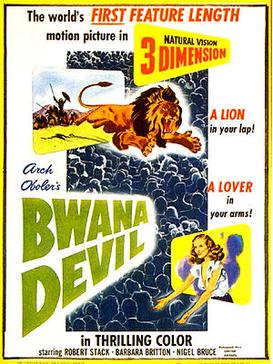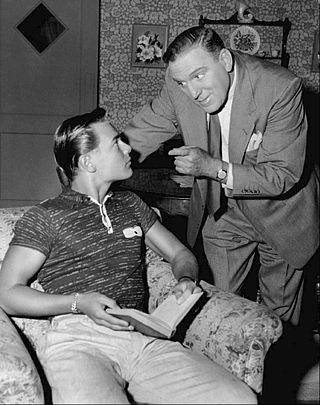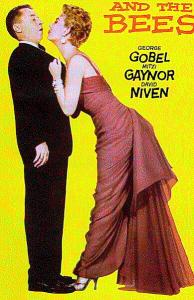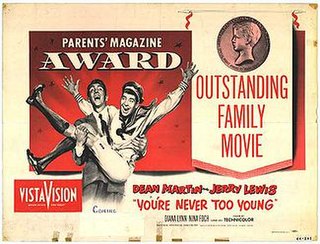
Footlight Parade is a 1933 American pre-Code musical film starring James Cagney, Joan Blondell, Ruby Keeler and Dick Powell and featuring Frank McHugh, Guy Kibbee, Hugh Herbert and Ruth Donnelly. The film was written by Manuel Seff and James Seymour based on a story by Robert Lord and Peter Milne, and was directed by Lloyd Bacon, with musical numbers created and directed by Busby Berkeley. The film's songs were written by Harry Warren (music), Al Dubin (lyrics), Sammy Fain (music) and Irving Kahal (lyrics), and include "By a Waterfall", "Honeymoon Hotel" and "Shanghai Lil".

Bwana Devil is a 1952 American adventure B movie written, directed, and produced by Arch Oboler, and starring Robert Stack, Barbara Britton, and Nigel Bruce. Bwana Devil is based on the true story of the Tsavo maneaters and filmed with the Natural Vision 3D system. The film is notable for sparking the first 3D film craze in the motion picture industry, as well as for being the first feature-length 3D film in color and the first 3D sound feature in English.

Lights Out is an American old-time radio program devoted mostly to horror and the supernatural.
Sidney W. Pink was an American film producer and occasional director. He has been called the father of feature-length 3-D movies. He is also noted for producing early Spaghetti Westerns and low-budget science-fiction films, and for his role in actor Dustin Hoffman's transition from stage to screen.

Hans Georg Conried Jr. was an American actor and comedian. He was known for providing the voices of George Darling and Captain Hook in Walt Disney's Peter Pan (1953), Snidely Whiplash in Jay Ward's Dudley Do-Right cartoons, Professor Waldo P. Wigglesworth in Ward's Hoppity Hooper cartoons, was host of Ward's "Fractured Flickers" and Professor Kropotkin on the radio and film versions of My Friend Irma. He also appeared as Uncle Tonoose on Danny Thomas' sitcom Make Room for Daddy, and twice on I Love Lucy.

The Life of Riley is an American radio situation comedy series of the 1940s that was adapted into a 1949 feature film, a 1950s television series, and a 1958 comic book.

The 5,000 Fingers of Dr. T. is a 1953 American musical fantasy film about a boy who dreams himself into a fantasy world ruled by a diabolical piano teacher enslaving children to practice piano forever. It was the only feature film written by Theodor Seuss Geisel, who wrote the story, screenplay, and lyrics. It was directed by Roy Rowland, with many uncredited takes directed by producer Stanley Kramer. The film stars Peter Lind Hayes, Mary Healy, Hans Conried, and Tommy Rettig.

My Friend Irma is a media franchise that was spawned by a top-rated, long-running radio situation comedy created by writer-director-producer Cy Howard. The radio show was so popular in the late 1940s that its success escalated the films, television, a comic strip and a comic book that comprise the franchise. Marie Wilson portrayed the title character Irma Peterson on radio, in two films and the television series. The radio series was broadcast on CBS from April 11, 1947 to August 23, 1954.

Louis Dilman Merrill was an American actor, who worked primarily in radio from the 1930s through the 1950s.

Fireside Theatre is an American anthology drama series that ran on NBC from 1949 to 1958, and was the first successful filmed series on American television. Productions were low-budget and often based on public domain stories or written by freelance writers such as Rod Serling. While it was panned by critics, it remained in the top ten most popular shows for most of its run. It predated the other major pioneer of filmed TV in America, I Love Lucy, by two years.

Gold Diggers of 1933 is a pre-Code Warner Bros. musical film directed by Mervyn LeRoy with songs by Harry Warren (music) and Al Dubin (lyrics), staged and choreographed by Busby Berkeley. It stars Warren William, Joan Blondell, Aline MacMahon, Ruby Keeler, and Dick Powell, and features Guy Kibbee, Ned Sparks and Ginger Rogers.

Arch Oboler was an American playwright, screenwriter, novelist, producer, and director who was active in radio, films, theater, and television. He generated much attention with his radio scripts, particularly the horror series Lights Out, and his work in radio remains the outstanding period of his career. Praised as one of broadcasting's top talents, he is regarded today as a key innovator of radio drama. Oboler's personality and ego were larger than life. Radio historian John Dunning wrote, "Few people were ambivalent when it came to Arch Oboler. He was one of those intense personalities who are liked and disliked with equal fire."

My Friend Irma is a 1949 American comedy film directed by George Marshall. It was the motion picture debut of the comedy team Dean Martin and Jerry Lewis. The film was released on August 16, 1949, by Paramount, and is based upon the CBS radio series My Friend Irma that first aired in 1947.

The Birds and the Bees is a 1956 screwball comedy film with songs, starring George Gobel, Mitzi Gaynor and David Niven. A remake of Preston Sturges' 1941 film The Lady Eve, which was based on a story by Monckton Hoffe, the film was directed by Norman Taurog and written by Sidney Sheldon. The costumes for the film were designed by Edith Head.

You’re Never Too Young is a 1955 American semi-musical comedy film directed by Norman Taurog and starring the team of Martin and Lewis and co-starring Diana Lynn, Nina Foch, and Raymond Burr. It was released on August 25, 1955 by Paramount Pictures.

Five is a 1951 American independent horror science fiction film that was produced, written, and directed by Arch Oboler. The film stars William Phipps, Susan Douglas Rubeš, James Anderson, Charles Lampkin, and Earl Lee. Five was distributed by Columbia Pictures.

Gloria Blondell was a stage, film, and television actress who was the younger sister of actress Joan Blondell.

Siren of Bagdad is a 1953 Technicolor fantasy adventure film produced by Sam Katzman and directed by Richard Quine set in the medieval Persian Empire. It stars Paul Henreid as a travelling Master magician who seeks to recover his troop of beautiful dancing girls who are to be sold into slavery. Patricia Medina portrays his love interest who seeks to overthrow the corrupt Grand Vizier with the magician's help.

No Minor Vices is a 1948 American black-and-white comedy film written by Arnold Manoff and directed by Lewis Milestone with Robert Aldrich as 1st assistant director. Created for David Loew's Enterprise Productions, it was the first of three films distributed by Metro-Goldwyn-Mayer after parting ways with United Artists, and was the last of four films made by Dana Andrews for director Milestone.
The Arnelo Affair is a 1947 American film noir starring John Hodiak, George Murphy, Frances Gifford, and Dean Stockwell, and co-written and directed by Arch Oboler.


















